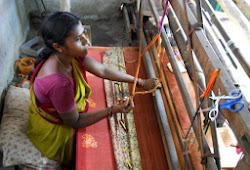Now You Know Loom Data Monitoring System in Weaving Industry
Monday, 28 May 2018
Edit
Loom Data Monitoring System
Gandhali Khandekar & Riyajahamad Mulla
D.K.T.E. Textile and Engineering Institute, Ichalkaranji, India
Email: rmulla12@gmail.com
D.K.T.E. Textile and Engineering Institute, Ichalkaranji, India
Email: rmulla12@gmail.com
Abstract
The main goal of today’s looms is to achieve maximum efficiency with high production so that a system comes into picture for achieving optimum quality and maximum production with certain features and configuration. Loom data system fulfills these requirements. It consists of 5 main parts in the structure with wired and wireless configuration. It can be used for single machine as well as for multiple machine control.
1) Introduction
“Loom data interpretation system” is an "Automated Information System" which will give you better control over production monitoring and take corrective steps immediately. Loom data system helps us to have better control over quality and production of the loom so that it will improve the “productivity” of the organization. The key to a profitable and successful weaving shed is the management of the shed to ensure it is achieving maximum efficiency. Productivity is assured by the continuous Performance of every single loom in the Mill. Unwanted stoppages Spanner in the works and drastically Impact production schedules. That is why it is imperative to invest in Online Production Monitoring Systems. The idea of having a system that will provide a Real-Time view of the shed gives birth to loom data system. There are many software companies which are developing the software for loom data system so that it will be very economical and efficient.
WHY DO WE ANALYZE DATA
The purpose of analyzing data is to obtain usable and useful information. The analysis, irrespective of whether the data is qualitative or quantitative, may:- describe and summaries the data
- identify relationships between variables
- compare variables
- identify the difference between variables
- forecast outcomes
Also by interpretating the data we can take proper corrective action as per the reports. Hence it is necessary to do proper analysis of the data.
1.1) Structure Of The System
Loom data system consists of 5 main parts which are as follows;
Loom data system consists of 5 main parts which are as follows;
A) Data collection unit
B) Software
C) Configuration
D) Reports
E) Interpretation
Loom data system comes with structure which facilitates continuous monitoring of each machine individually and collectively.
1.1.1) Data collection unit
There is a data collection unit comes with an in-built microprocessor, an user friendly keyboard and LED display for ease of operation. The data collected from the looms are transferred to a central computer online. There are two types of data collection units:
a) Single machine type
b) Multichannel machine type
a) Single machine type
Here data collected from machine is displayed on display. Machine will automatically stop when reaches the specified meter and the red indicator will blink. Reset key is available to reset or restart the machine. Display shows current RPM, breakages, efficiency, etc.
b) Multichannel machine type
Using this type of data collection unit, data is collected from group of machines. It is very efficient and cost effective model. Here also we have a display on which by selecting machine number we can see the machine information. It is very efficient and cost effective model.
1.1.2) Software
Software is installed in a main computer. This software collects the data from the data collection unit and generates various reports to take corrective action. Software can be installed on various nodes across the plant.
With the use of latest technology, the system is most simple; 'Plug and play' type and the looms can be continuously monitored inside factory on mobile phones, laptops, Desktops over LAN and Wi-Fi without any software installation! The software acquires the data from the looms and arranges in well structured reports, which can be easily interpreted. It has The Facility to transfer the data to an ERP system.
1.1.3) Configuration
There are two types of configuration
a. Wired configuration
b. Wireless configuration
In wired configuration wires are used which is called as LAN connection while in wireless configuration looms are connected with WIFI connection.
a. Wired configuration
 |
| Fig: Wired configuration |
b. Wireless configuration
 |
| Fig: Wireless configuration |
1.1.4) Reports
Loom data system gives all the production related reports on the display or on printer, so that user can get all the information at their fingertips.
Loom data system gives all the production related reports on the display or on printer, so that user can get all the information at their fingertips.
Related:
- Efficiency report
- Yarn Reports
- Warping Reports
- Sizing Reports
- Weaving Reports
- Inspection Reports
- Miscellaneous Report
at their fingertips.
These Reports can be obtained in
- Day wise
- Shift wise
- Hour wise
After getting the reports we can compare the reports Shift wise, Operator wise, Machine wise. We can also judge the loom performance according to reports obtained from that loom.
2) Features
Features of the loom data system can be listed as follows;
- Humidity and Temperature Sensors
- SMS alerts & Reports by e-mail
- Mobile monitoring
- Fabric inspection
- Security module
- Radio Frequency Identification Module
- Applicable to all types of looms
- Multiple Looms Connectivity
- Computer based automation
- Auto Stop Facility with Fault Detection
Atmospheric temperature and humidity in the department can be sensed by using the sensors. This is the main feature of the loom data system. If there is change in temperature and humidity in the department then alarm starts to blow so that user can easily notice that change and take corrective action immediately.
 |
| Fig: Humidity and Temperature monitoring |
B) SMS alerts & Reports by e-mail
The SMS alerts can be leveraged to ensure that the relevant people are informed automatically on occurrence of any problems with the machines. The alerts can be configured for different alert levels for example the first level alert may go to first tier management but if the problem persists the second level alert can be sent to upper management. Upper management specific alerts can also be defined to ensure shed mangers perform duties in a timely manner.
The SMS alerts can be leveraged to ensure that the relevant people are informed automatically on occurrence of any problems with the machines. The alerts can be configured for different alert levels for example the first level alert may go to first tier management but if the problem persists the second level alert can be sent to upper management. Upper management specific alerts can also be defined to ensure shed mangers perform duties in a timely manner.
 |
| Fig: SMS alerts |
C) Mobile monitoring
Now-a-days business leaders are involved in many diverse business sectors and do not have the time to sit in one location. So that loom data system provides mobile monitoring to have better control over the business. Hence weather you are in or out of the office you can keep an eye on your business round the clock.
 |
| Fig: Mobile monitoring |
D) Radio Frequency Identification Module
Loom data system detect loom short stop causes (warp, weft, leno, pile etc...) through the wireless loom data devices where as long stop causes are assigned by RFID cards. This not only assigns stop causes but also authenticates the inputting personnel, giving you the data needed to monitor the time taken in machine troubleshooting (mechanical, electrical etc...) and knotting/article change. To further take benefit of the RFID devices weavers attendance and in/out can also be tracked so accurate record are available to be used in weaver's efficiencies and rewards system.
Loom data system detect loom short stop causes (warp, weft, leno, pile etc...) through the wireless loom data devices where as long stop causes are assigned by RFID cards. This not only assigns stop causes but also authenticates the inputting personnel, giving you the data needed to monitor the time taken in machine troubleshooting (mechanical, electrical etc...) and knotting/article change. To further take benefit of the RFID devices weavers attendance and in/out can also be tracked so accurate record are available to be used in weaver's efficiencies and rewards system.
 |
| Fig: RFID device |
E) Fabric inspection
Fabric Inspection is another feature of this system. Fabric delivered by the loom is directly inspected on the loom itself, so that fabric inspection process can be eliminated. It will reduce the cost of production. Giving more profit.
 |
| Fig: Fabric inspection |
3) Benefits of loom data system
Data interpretation is relies on data gathered during the collection period to make informed decisions about how to proceed. The process also uses the information gathered during initial analysis to come to a conclusion about what changes, if any, are important enough to pursue for future action. That action is taken according to information came from the data system which results in improving quality and production.
- Centralized Information of all machine types
- Easy identification of Efficiency of the machines
- Comparison reports on Machines, Weavers, Shifts, etc.
- Combination of loom types on one computer
- Shift wise production display with quality
- Previous Records Storage
- Quality sensitive production measurement
- On Line Display & Reports
Data interpretation is relies on data gathered during the collection period to make informed decisions about how to proceed. The process also uses the information gathered during initial analysis to come to a conclusion about what changes, if any, are important enough to pursue for future action. That action is taken according to information came from the data system which results in improving quality and production.
5) References
- Shahbaz Akhter, Loom Data Wireless Weaving Monitoring & Planning, Published on July 25, 2015.
- Official website of Electrocom technology pvt. Ltd., India
- Classic loom data logger Online Data Acquisition System for Textiles (www.clddatalogger.com)
- www.semitronik.com
- “Loom production monitoring system” using ‘All the production sensor with web interface unit’.
You can also like:
- Automation Process in Weaving Machinery
- Automation in Textile Manufacturing Process
- Automation in Weaving Process | Why is Automation Important in the Weaving Sector?
- Why Automation is Necessary in the Textile Industry?
- Automation in Weaving Shed, Electronic Let-off, Take-up Mechanism and Stop Motion
- Automation in Warping and Sizing Process
- Recent Developments in Spinning, Weaving and Wet Processing Industry
Sumber http://textilelearner.blogspot.com






